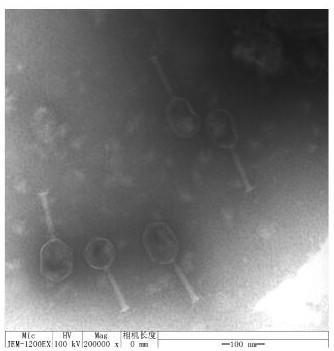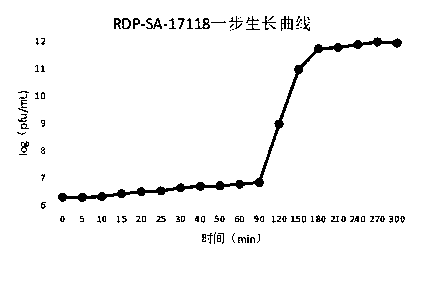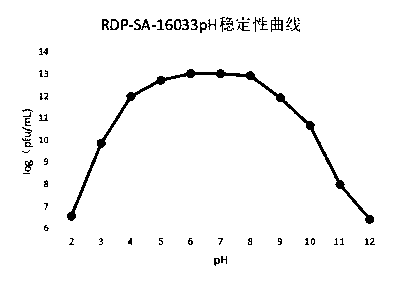A strain of Proteus mirabilis phage rdp-sa-16033 and its industrial production process
A technology of RDP-SA-16033, Proteus mirabilis, applied in the field of microorganisms, can solve the problems of antibiotic abuse and bacterial resistance, and achieve the effects of high titer, good product stability, and high temperature tolerance
- Summary
- Abstract
- Description
- Claims
- Application Information
AI Technical Summary
Problems solved by technology
Method used
Image
Examples
Embodiment 1
[0037] Example 1 Isolation and identification of pathogenic Proteus mirabilis S5
[0038] Sampling from the diseased farm, taking the liver of the diseased poultry through aseptic operation, streaking on the selective medium, and culturing at 37°C for 18-24 hours, a red colony with round, flat, neat edges, smooth and moist surface formed on the medium , pick a typical colony and continue to streak and purify 3 times, then pick a single colony and inoculate it in 5 mL of LB broth medium, shake it at 200 rpm for 8 hours at 37°C, and obtain a uniform turbid bacterial suspension. Then through 16sRNA molecular identification and serotype identification, it was determined to be pathogenic Proteus mirabilis, and one of them was named S5, which was stored in a -80°C refrigerator by glycerol preservation.
Embodiment 2
[0039] Example 2 Isolation and Identification of Phage RDP-SA-16033
[0040] Sample processing: collect diseased material from the broiler farm, dissect the liver, grind it with a sterilized grinder, then add 2 times the volume of normal saline, shake for 10 minutes, then centrifuge at 12000 rpm for 10 minutes, and take the supernatant to pass through a 0.22 μm filter , collect the filtrate for later use.
[0041] Concentration of phage: Add 10% GEG8000 to the collected supernatant, let it stand at 4°C for 4-6 hours, centrifuge at 12000rpm for 10min, discard the supernatant, dissolve the precipitate with a small amount of normal saline, and collect the solution for later use.
[0042]Phage proliferation: Add 0.2mL of bacterial suspension and 0.5mL of lysate to 5mL of LB broth, culture overnight at 37°C with shaking at 200rpm, then centrifuge at 12000rpm for 5min, take the supernatant and pass it through a 0.22μm filter, and collect the filtrate for later use.
[0043] Phage i...
Embodiment 3
[0046] Embodiment 3: Electron microscope observation of phage
[0047] Take 20 μL of the liquid containing crude phage particles and drop it on the copper grid, let it settle naturally for 15 min, absorb the excess liquid from the side with filter paper, add a drop of 2% phosphotungstic acid (PTA) on the copper grid to stain the phage for 10 min, and then Use filter paper to absorb the staining solution from the side, and observe the phage morphology with an electron microscope after the sample is dry.
[0048] The bacteriophage RDP-SA-16033 has a polyhedral three-dimensional symmetrical head wrapped around nucleic acid, with a diameter of about 70nm, a tail of about 150nm in length, a tail sheath, and a neck connecting the head and tail. According to the Ninth Report of the International Virus Taxonomy Organization Virus Classification, the phage can be classified as Myoviridae of the order Myoviridae. refer to figure 1 shown.
PUM
| Property | Measurement | Unit |
|---|---|---|
| Incubation period | aaaaa | aaaaa |
| Potency | aaaaa | aaaaa |
| Potency | aaaaa | aaaaa |
Abstract
Description
Claims
Application Information
 Login to View More
Login to View More - R&D
- Intellectual Property
- Life Sciences
- Materials
- Tech Scout
- Unparalleled Data Quality
- Higher Quality Content
- 60% Fewer Hallucinations
Browse by: Latest US Patents, China's latest patents, Technical Efficacy Thesaurus, Application Domain, Technology Topic, Popular Technical Reports.
© 2025 PatSnap. All rights reserved.Legal|Privacy policy|Modern Slavery Act Transparency Statement|Sitemap|About US| Contact US: help@patsnap.com



